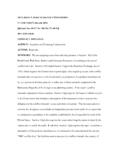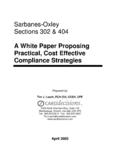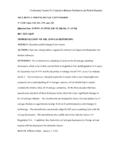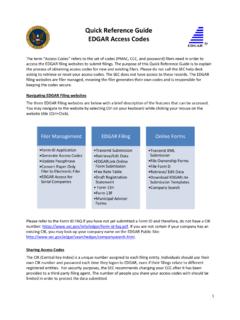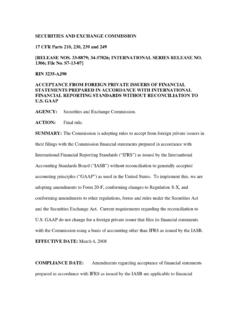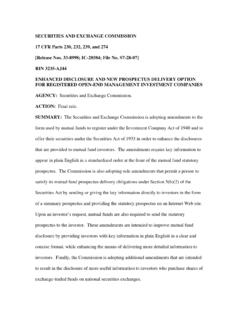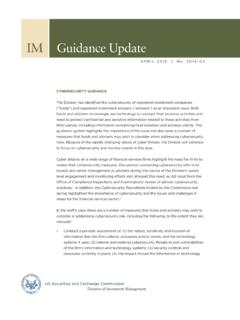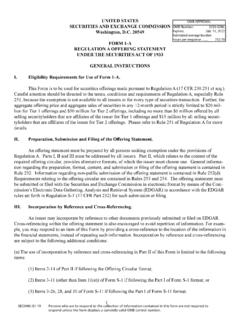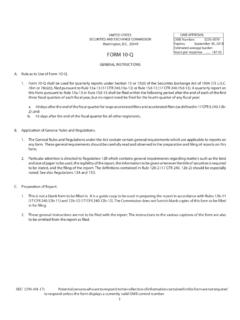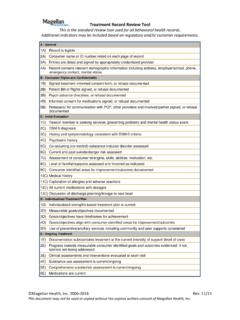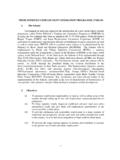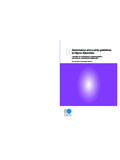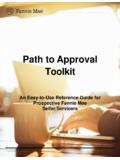Transcription of FinCEN 314(a) Fact Sheet - SEC.gov
1 March 15, 2007 FinCEN s 314(a) fact Sheet Section 314(a) of the USA PATRIOT Act of 2001 ( 107-56)1, required the Secretary of the Treasury to adopt regulations to encourage regulatory authorities and law enforcement authorities to share with financial institutions information regarding individuals, entities, and organizations engaged in or reasonably suspected, based on credible evidence, of engaging in terrorist acts or money laundering activities. FinCEN issued a proposed rule on March 5, 2002, and the final rule on September 26, 2002 (67 Fed. Reg. 60,579). Section 314(a) requirements are now published in 31 CFR Part Overview FinCEN s regulations under Section 314(a) enables federal law enforcement agencies, through FinCEN , to reach out to more than 45,000 points of contact at more than 27,000 financial institutions to locate accounts and transactions of persons that may be involved in terrorism or money laundering.
2 FinCEN receives requests from federal law enforcement and upon review, sends requests to designated contacts within financial institutions across the country once every 2 weeks via either a secure Internet web site or via facsimile. The requests contain subject and business names, addresses, and as much identifying data as possible to assist the financial industry in searching their records. The financial institutions must query their records for data matches, including accounts maintained by the named subject during the preceding 12 months and transactions conducted within the last 6 months. Financial institutions have 2 weeks from the transmission date of the request to respond to 314(a) requests.
3 If the search does not uncover any matching of accounts or transactions, the financial institution is instructed not to reply to the 314(a) request. FinCEN began processing 314(a) requests in November 2002. This system was temporarily suspended, based on feedback from system users. Following extensive consultations, FinCEN issued FAQ s to implement and streamline the process and resumed operation of the system in February 2003. Since that time, as with any new system, the process continues to be fine-tuned. On March 1, 2005, FinCEN ceased notifying the financial industry with e-mail attachments and began posting 314(a) requests on a secure Internet site.
4 1 Section 314 is reprinted in the Historical and Statutory Notes to 31 5311. The Process Through an expedited communication system, FinCEN s 314(a) process enables an investigator to canvas the nation s financial institutions for potential lead information that might otherwise never be uncovered. The focus quickly zeros in on relevant locations and activities. This cooperative partnership between the financial community and law enforcement allows disparate bits of information to be identified, centralized and rapidly evaluated. It is important to note, however, that Section 314(a) provides lead information only and is not a substitute for a subpoena or other legal process.
5 To obtain documents from a financial institution that has reported a match, a law enforcement agency must meet the legal standards that apply to the particular investigative tool that it chooses to use to obtain the documents. To ensure that Section 314(a) inquiries are being used only for appropriate cases, FinCEN s Section 314(a) process requires federal law enforcement to provide assurances that the request has been subject to appropriate scrutiny at the agency level and that the matter under investigation satisfies FinCEN s standards for processing a formal Section 314(a) inquiry. FinCEN requires all requesters to submit a form certifying that the investigation is based on credible evidence of terrorist financing or money laundering.
6 Criteria for Money Laundering Requests Because money laundering encompasses such a wide range of underlying criminal activity, agencies must determine that a money laundering case is significant before submitting a 314(a) request to FinCEN . To ensure that this standard is met, FinCEN requires documentation showing the size or impact of the case, the seriousness of the underlying criminal activity, the importance of the case to a major agency program, and any other facts demonstrating its significance. In addition, law enforcement must certify in cases involving money laundering that all traditional means of investigation have been exhausted.
7 The support for the assertion that other investigative alternatives have been exhausted or are unavailable must be provided in the form submitted to FinCEN for review prior to the request being submitted to financial institutions by FinCEN . To date, the 314(a) process already has proved to be successful, as illustrated below. Results have yielded productive leads for both terrorist financing and money laundering investigations. The immediate matches have, for example, led to the identification of new accounts, transactions, indictments, etc. and enabled law enforcement to efficiently direct its use of legal processes to promptly obtain critical evidence in numerous cases.
8 Examples of 314(a) requests, based on money laundering, include: Hawala operation involving a sanctioned country Arms trafficking Alien smuggling resulting in fatalities Cigarette smuggling Nationwide investment fraud with many victims International criminal network involved in identity theft and wire fraud Multi-agency investigation of drug trafficking rings Results The 314(a) system has processed 630 requests submitted by ywenty Federal agencies from November 1, 2002 March 13, 2007. Federal law enforcement organizations (LE) have submitted cases in the conduct of the following significant criminal investigations: Terrorism/Terrorist Financing 220 cases Money Laundering 410 cases The investigations identified 5,316 subjects of interest.
9 Of these, financial institutions (FI) responded with 36,147 total subject matches: 35,109 positive and 1,038 inconclusive. Feedback from Law Enforcement The 314(a) feedback from the law enforcement requesters has been overwhelmingly positive and has resulted in the discovery and/or issuance of the following: 2,220 New Accounts Identified 3,305 New Transactions 1,446 Grand Jury Subpoenas 21 Search Warrants 436 Administrative Subpoenas/Summons/Other 100 Arrests 112 Indictments 9 Convictions $22,887, Total Dollar Amount Located

